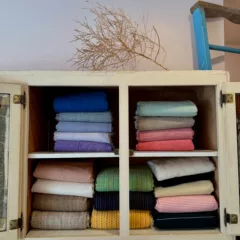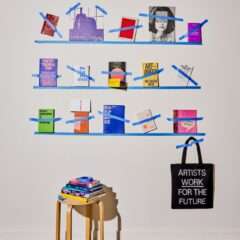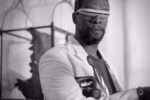Much of the work in Think Global 2 at Pentimenti reflects a shared mindset of lowered expectations, with artists channeling environmental concerns or worries about the world economy. In the exhibition open until July 9, the art is a reflection of a larger, collective mood of doubt.
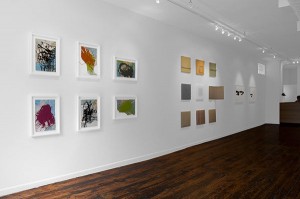
With matter-of-fact titles like “The undeniable truth about the eastern United States” and “Europe has been through a lot,” Tim Eads dryly states the impact of the mounting, ecological crisis, or so it seems. His found maps of countries and continents drip with house paint and bring to mind natural disasters, oil spills, toxic waste, and other corrosive effects on the environment.
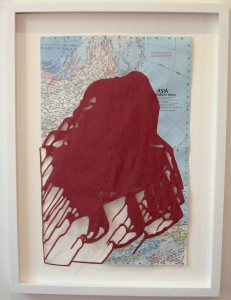
Between dripped trails, certain portions of the maps, showing coastal or landlocked areas, have been cut out, leaving no area exempt from potential damage. Each splatter of paint with its artificial color reads as an unnatural presence, and Eads’ use of the synthetic product points to the difficulty of finding sustainable alternatives.
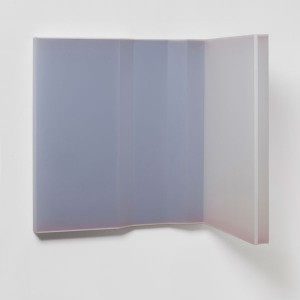
Jacque Liu’s mylar works, which he refers to as drawings, are difficult to categorize in strict terms. Shielded by translucent mylar, the works appear from a frontal perspective as flat, minimalist compositions, while from other viewpoints their sculptural character is revealed. Each drawing references architectural details from the artist’s travels. By offering competing side and frontal views, each drawing suggests a subjective recollection of events. The artist also has graphite drawings on paper that resemble topographical mappings. Entitled “Nainai #2-#4,” each seems drawn from memory to present an imagined landscape.
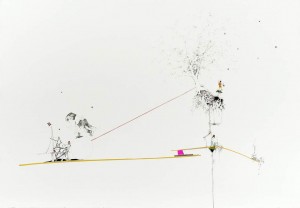
The precariously balanced structures in Laura Ledbetter’s “Charles and Albert” and “George and Paul” appear as if they are going to collapse at any moment. With miniature figures surrounded by miniature building debris and domestic items, each drawing suggests an unstable environment and economic uncertainty.
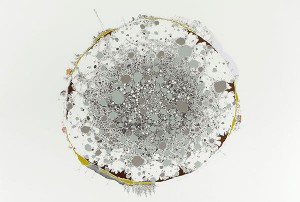
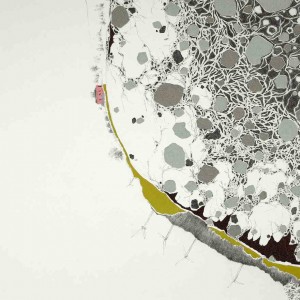
In the artist’s other drawing with cut paper, entitled “728.2 MI. 08/10,” houses and other objects in the built environment (wind turbines) encircle what looks like a cut-away view of a landmass. However the earth appears microscopic and cellular and, as a result, more vulnerable and fragile. The houses and their occupants become parasitic.
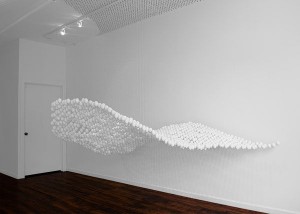
With its sprawling size and use of 1,454 eggs, Leah Frankel’s sculpture “Surface” is the show’s most visible metaphor for fragility. Natural forms inspire both it and Frankel’s other sculpture, “Book Contour,” and each sculpture is created using mathematical calculations. Resembling a wave formation, the swaying eggs in “Surface” plot each moving point. The artist’s use of hand-blown eggs as a material makes the work and nature seem ephemeral and fragile.
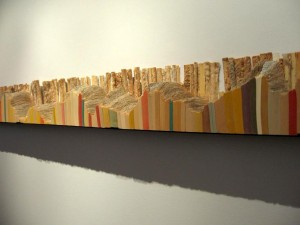
In “Book Contour,” the artist cuts through a series of lined-up paperbacks to suggest the topography of a landscape. The missing text makes the form appear eroded, and with the divisions created by different colored books, the work seems like an attempt to analyze the deteriorating landscape.
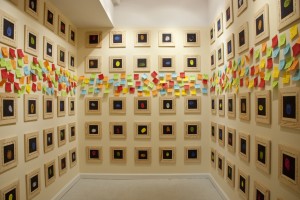
Asking visitors to write a wish or fear they had on a sticky-note accompanied by their identifying thumb print, Linda Brenner and Judy Gelles extended their one-day project at Love Park, where they asked passersby to record the same. The results from both projects are displayed in the gallery’s Project Room. From concerns about new jobs, safe travels, and relationships, to the self-doubting “World Peace?,” the resulting fears and desires, like the other works in the gallery, range from personal issues to more global struggles. And with personal responses that are either humble requests or larger hopes that can be dismissed as platitudes, the participants seem to share in the artists’ reluctance to hope for more.


